Generate and Test
CS314
Take from a list¶
take(HasX,X,NoX) removes exactly one element X from the list HasX with the result list being NoX.
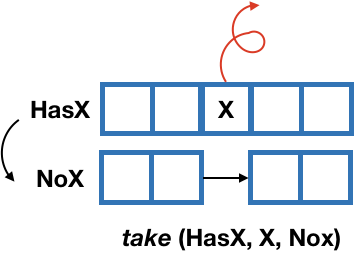
take(HasX,X,NoX) removes exactly one element X from the list HasX with the result list being NoX.
take([H|T],H,T).
take([H|T],R,[H|S]) :- take(T,R,S).

Read the second clause as, "Given a list [H|T] you can take R from the list and leave [H|S] if you can take R from T and leave S".
Take from a list¶
?- take([1,2,3],1, Y).
?- take([2,3],1,X).
?- take([1,2,3],X,Y).
Permutation¶
We can now build permutation using take.
perm([],[]).
perm(L,[H|T]) :- take(L,H,R), perm(R,T).

?- perm([1,2,3],X).
Generate and test¶
- A design pattern for logic programming.
- Generate a candidate solution and then test if the solution satisfies the condition.
Dutch national flag¶

- A famous problem formulated by Edsger Dijkstra.
- Given a list with colours red, white and blue, return a list such that it has all the reds, and then white followed by blue.
- Essentially a sorting problem.
Dutch national flag¶
Implement a predicate checkFlag(L) to see whether the list L contains the colours in the right order.
checkRed([red|T]) :- checkRed(T).
checkRed([white|T]) :- checkWhite(T).
checkWhite([white|T]) :- checkWhite(T).
checkWhite([blue|T]) :- checkBlue(T).
checkBlue([blue|T]) :- checkBlue(T).
checkBlue([]).
checkFlag(L) :- checkRed(L).

?- checkFlag([red,white,blue,blue]).
?- checkFlag([white,red,blue,blue]).
Quiz¶
checkRed([red|T]) :- checkRed(T).
checkRed([white|T]) :- checkWhite(T).
checkWhite([white|T]) :- checkWhite(T).
checkWhite([blue|T]) :- checkBlue(T).
checkBlue([blue|T]) :- checkBlue(T).
checkBlue([]).
checkFlag(L) :- checkRed(L).
Which one of the following queries is true?
?- checkFlag([white,blue]).?- checkFlag([blue]).?- checkFlag([]).

Quiz¶
Which one of the following queries is true?
?- checkFlag([white,blue]).true?- checkFlag([blue]).false?- checkFlag([]).false

How can we prevent the first predicate from holding?
Better flag check¶
Introduce a new state chkRed2 in the transition system.
chkRed([red|T]) :- chkRed2(T).
chkRed2([red|T]) :- chkRed2(T).
chkRed2([white|T]) :- chkWhite(T).
chkWhite([white|T]) :- chkWhite(T).
chkWhite([blue|T]) :- chkBlue(T).
chkBlue([blue|T]) :- chkBlue(T).
chkBlue([]).
chkFlag(L) :- chkRed(L).

?- chkFlag([white,blue]).
Make the dutch national flag¶
Using the predicate mkFlag(L,F) which makes the flag F from the list of colours in L.
mkFlag(L,F) :- perm(L,F), chkFlag(F).
?- mkFlag([white,red,blue,blue,blue],F) {1}.
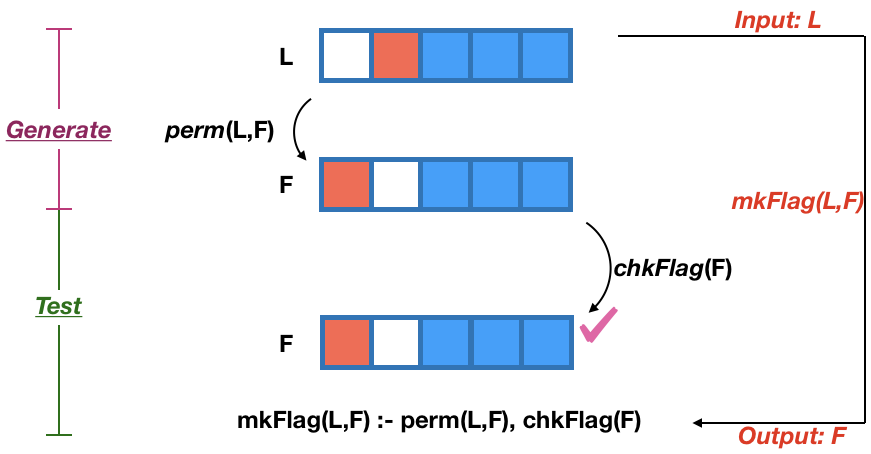
In the above, perm is the generate and chkFlag is the test.
Essence of generate and test¶
- Generate a solution.
- Test if it is valid.
- If not valid, backtrack and try another solution.
Sorting¶
We can generalise our solution to the Dutch national flag problem to sorting.
Let us define a predicate sorted(L) which holds if L is sorted.
sorted([]).
sorted([H]).
sorted([A,B|T]) :- A =< B, sorted([B|T]).

?- sorted([1,2,3,4]).
?- sorted([1,3,2,4]).
Sorting¶
Now sorting can be defined using the predicate permsort(L,SL), where SL is the sorted version of L.
permsort(L,SL) :- perm(L,SL), sorted(SL).
?- permsort([1,3,5,2,4,6], SL).
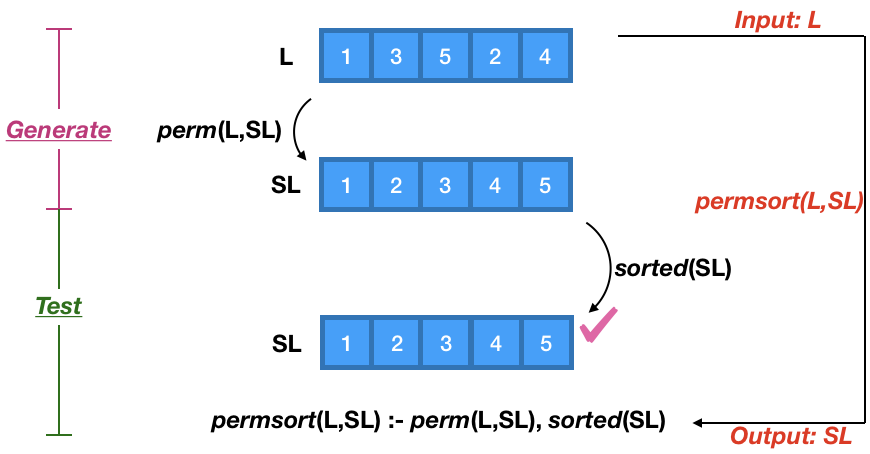
- Generating all the permutations and checking for sortedness is a terrible idea.
- A better approach is to divide and conquer.
Quicksort¶
- A bit of a digression from generate and test.
- Use divide and conquer to sort the results.
- First, define the predicate
partition(L,X,LES,GS)that given a listLand an elementXpartitions the list into two.- The first is
LESwhich contains elements fromLless than or equal toXand GSwhich contains elements fromLgreater thanX.
- The first is
Quicksort¶
Let's first define a partition predicate partition(Xs,X,Ls,Rs) that partitions elements in Xs into Ls and Rs where $\forall E \in Ls. E =< X$ and $\forall E \in Rs. E > X$.
partition([],Y,[],[]).
partition([X|Xs],Y,[X|Ls],Rs) :- X =< Y, partition(Xs,Y,Ls,Rs).
partition([X|Xs],Y,Ls,[X|Rs]) :- X > Y, partition(Xs,Y,Ls,Rs).

?- partition([6,5,3,2,1,0],4,X,Y).
Quicksort¶
Quicksort works by partitioning the list into two, sorting each one, and appending to get the resultant sorted list.
quicksort([H|T],SL) :-
partition(T,H,Ls,Rs), quicksort(Ls,SLs), quicksort(Rs,SRs), append(SLs,[H|SRs],SL).
quicksort([],[]).
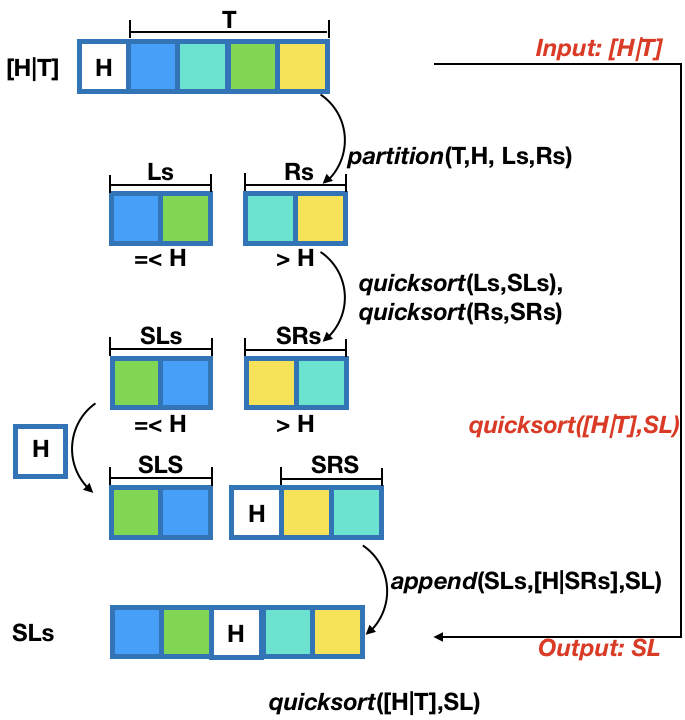
?- quicksort([6,5,4,3,2,1,0],SL).
N-Queens problem¶
Find the assignment of N-queens on a NxN chessboard such that none of the queens threaten each other.
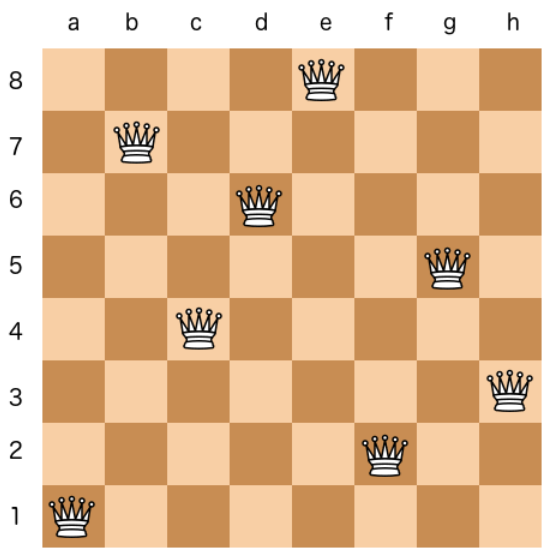
N-Queens Problem¶
- If two queens are on the same row or same column, they threaten each other.
- So design the data structure such that such cases are ruled out.
- Represent the positions of the queens as a permutation of
[1,2,3,...,N].- Each number represents the position of the queen in that row.
[1,6,8,3,7,4,2,5]says that the first queen is on (1,1), second on (2,6), thrid on (3,8), forth on (4,3), fifith on (5,7), ...- The soution, if it exists, is a permutation of
[1,2,3,...,N].
Represent the positions of the queens as a permutation of
[1,2,3,...,N].- Each number represents the position of the queen in that row.
[1,6,8,3,7,4,2,5]says that the first queen is on (1,1), second on (2,6), thrid on (3,8), forth on (4,3), fifith on (5,7), ...- The soution, if it exists, is a permutation of
[1,2,3,...,N].
Importantly, two queens cannot be on the same row or column.
- No need to check for this condition while checking validity.
- Such permutations aren't even generated, making the search fast.

N-Queens problem¶

checkBoard([H|T]) :- L is H-1, R is H+1, checkRow(T,L,R), checkBoard(T).
checkRow([H|T],L,R) :- H =\= L, H =\= R, LN is L-1, RN is R+1, checkRow(T,LN,RN).
checkBoard([]).
checkRow([],_,_).

Example:


8-Queens Problem¶

?- checkBoard([1,6,8,3,7,4,2,5]).
queens(B) :- perm([ 1, 2, 3, 4, 5, 6, 7, 8 ], B), checkBoard(B).
?- queens(B) {1}.
8-queens Problem¶
There are 92 solutions to 8-Queens problem. We can find them all.
?- queens(B) {92}.